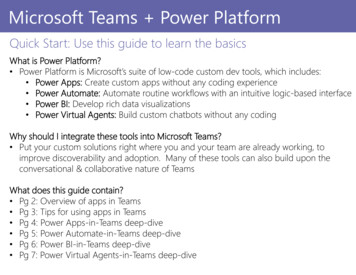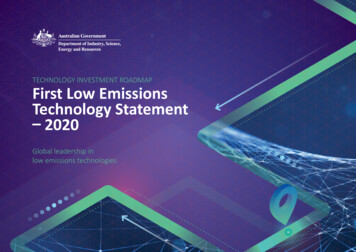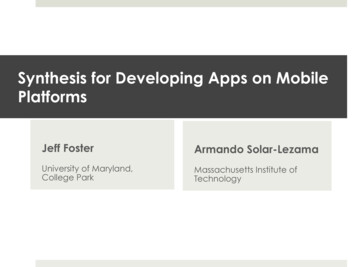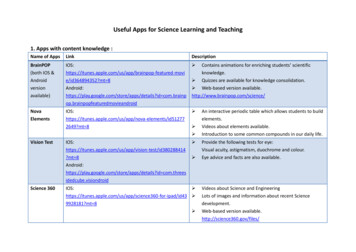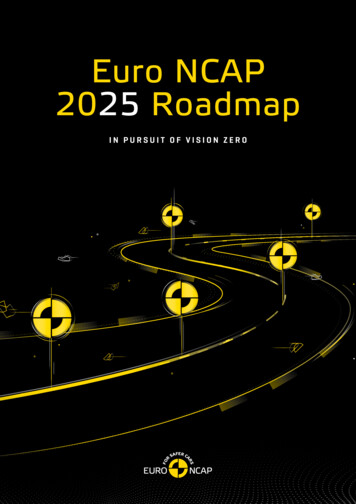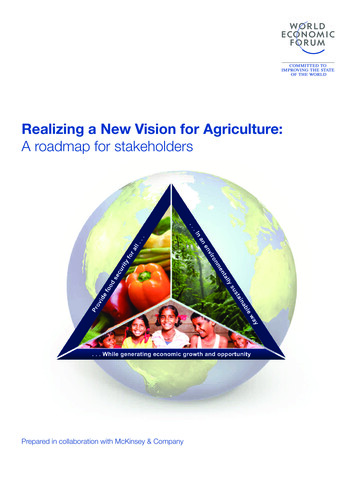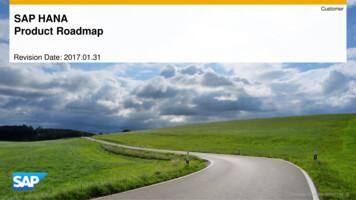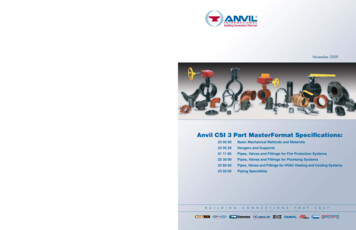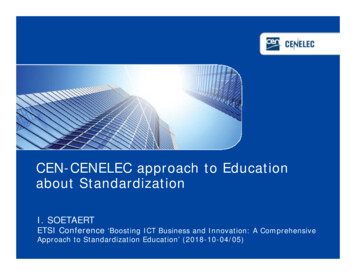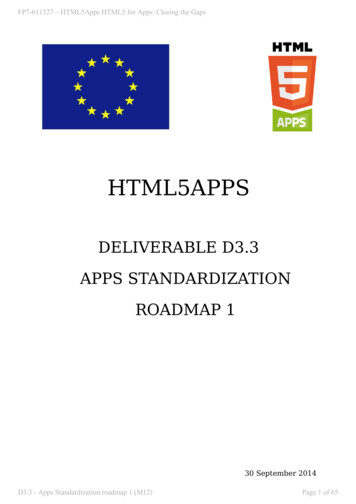
Transcription
FP7-611327—HTML5Apps HTML5 for Apps: Closing the GapsHTML5APPSDELIVERABLE D3.3APPS STANDARDIZATIONROADMAP 130 September 2014D3.3 - Apps Standardization roadmap 1 (M12)Page 1 of 65
FP7-611327—HTML5Apps HTML5 for Apps: Closing the GapsProjectGrant Agreement number611327Project acronym:HTML5AppsProject title:HTML5Apps: Closing the GapsFunding Scheme:Coordination & Support ActionDate of latest version of Annex Iagainst which the assessment willbe made:May 24, 2013DocumentDeliverable number:D3.3Deliverable titleApps Standardization roadmap 1Contractual Date of DeliveryM12Actual Data of Delivery:M12Editor(s):Dominique Hazael-MassieuxAuthor(s):Reviewer(s):Philipp Hoschka, Daniel DardaillerPartipant(s):Work package no.:3Work package title:Standards CoordinationWork package leader:Daniel nal:FinalTotal number of pages (includingcover):65Keywords:D3.3 - Apps Standardization roadmap 1 (M12)Page 2 of 65
FP7-611327—HTML5Apps HTML5 for Apps: Closing the GapsDISCLAIMERThis document contains description of the HTML5Apps project work andfindings. The authors of this document have taken any available measure inorder for its content to be accurate, consistent and lawful. However, neitherthe project consortium as a whole nor the individual partners that implicitlyor explicitly participated in the creation and publication of this documenthold any responsibility for actions that might occur as a result of using itscontent.This publication has been produced with the assistance of the EuropeanUnion. The content of this publication is the sole responsibility of theHTML5Apps consortium and can in no way be taken to reflect the views ofthe European Union.TheEuropeanUnionisestablished in accordance withthe Treaty on European Union(Maastricht). There are currently27 Member States of the Union.It is based on the EuropeanCommunities and the memberstates cooperation in the fields ofCommon Foreign and SecurityPolicy and Justice and HomeAffairs. The five main institutionsof the European Union are opean Commission, the Courtof Justice and the Court ofAuditors.(http://europa.eu/index en.html)HTML5Apps is a project funded in part by the European Union.D3.3 - Apps Standardization roadmap 1 (M12)Page 3 of 65
FP7-611327—HTML5Apps HTML5 for Apps: Closing the GapsD3.3 - Apps Standardization roadmap 1 (M12)Page 4 of 65
FP7-611327—HTML5Apps HTML5 for Apps: Closing the Gaps1. INTRODUCTIONTo facilitate information, coordination and participation of research projectswith respect to HTML5 app standardisation, the HTML5Apps project hasdeveloped a standardization roadmap outlining the current state ofstandardization efforts relevant to HTML5 apps inside and outside of W3C.This roadmap is published quarterly by the project and widely distributed.This version of the roadmap corresponds to the deliverable 3.3 as identifiedin the project Description of Work, matching the state of this roadmap afterthe first year of the project.D3.3 - Apps Standardization roadmap 1 (M12)Page 5 of 65
FP7-611327—HTML5Apps HTML5 for Apps: Closing the Gaps2. STANDARDS FOR WEB APPLICATIONS ONMOBILE: CURRENT STATE AND ROADMAPLatest te/This ate/ (PDF version)Previous ate/Web technologies have become powerful enough that they are used to buildfull-featured applications; this has been true for many years in the desktopand laptop computer realm, but is increasingly so on mobile devices as well.This document summarizes the various technologies developed in W3C thatincrease the capabilities of Web applications, and how they apply morespecifically to the mobile context. A good subset of these technologies aredescribed and explained in the W3C on-line training on programming raphicsMultimediaDevice AdaptationFormsUser interactionsData storagePersonal Information ManagementSensors and hardware integrationNetworkCommunication & DiscoveryPackagingPaymentPerformance & OptimizationPrivacy & SecurityD3.3 - Apps Standardization roadmap 1 (M12)Page 6 of 65
FP7-611327—HTML5Apps HTML5 for Apps: Closing the Gaps2.1. STATUS AND CHANGESThis document is the 14th edition of this overview of mobile Webapplications technologies. The previous edition was released in April 2014.A live version of this document accepts contributions on the W3C Web andMobile Interest Group Github repository.This document is published by the Web and Mobile Interest Group; feedbackon every aspect of this document should be sent to public-webmobile@w3.org, the publicly archived mailing list of the interest group, orraised as issues on the Github repository, or alternatively to the author(dom@w3.org). It will serve as input for the next iteration of the document.A new section in this edition covers the emerging field of integratedpayments on the Web, following recent work started by W3C in this space.It documents the following changes in the Web platform since April 2014:Emerging work early work on a Wake Lock API, that would enable developers toprevent their users device to go on standby mode, has started inthe Device APIs Working Group; early work on a geofencing API has started in the GeolocationWorking Group; early work on a background synchronization API for browsers,based on Service Worker, has started; an alternative to Network Service Discovery (whose futureremains unclear) has emerged as an early proposal called NamedWeb Sockets; early work on credential management and on-line authorizationintegration is being discussed in the Web Applications WorkingGroup; work on a new version of the Indexed Database API is underconsideration in the Web Applications Working Group; a Web Bluetooth Community Group was started to look at an inbrowser API to interact with Bluetooth Low Energy devices;Published as First Public Working Draft the First Public Working Draft of Service Workers, a mechanismthat enables powerful off-line Web applications, was released; the First Public Working Draft of WOFF 2.0, the optimized fontfile format format for the Web, was released; the First Public Working Draft of Media Queries level 4, makingit possible to taylor the style and layout of a Web page to e.g. theambient light environment, was released;Reached Last Call CSS Font Loading Module Level 3 was published as a Last CallWorking Draft; the Beacon API, allowing to ask the browser to make HTTPrequests after a page has been closed, was published as a LastCall Working Draft;D3.3 - Apps Standardization roadmap 1 (M12)Page 7 of 65
FP7-611327—HTML5Apps HTML5 for Apps: Closing the GapsReturned to Last Call the Canvas API returned to Last Call Working Draft status to addimportant accessibility features; HTML Media Capture, Ambident Light events returned to LastCall Working Draft status to take into account implementorsfeedback;Reached Candidate Recommendation the HTML5 specification was published as updated CandidateRecommendation (after a short Last Call Working Draft), on itsfinal stretch to W3C Recommendation status later this year;Specification merged, split or abandoned the srcset attribute and picture element, used to createresponsive images, were merged into the HTML 5.1 specification,as their first implementations in browsers are emerging;Newly tracked the document now tracks viewport-relative CSS units and CSSMobile text size adjustment that helps make Web pages adapt tothe underlying device; the ability of the autocomplete attribute in HTML 5.1 to helpfill contact information and credit card data is now specificallytracked in this document;D3.3 - Apps Standardization roadmap 1 (M12)Page 8 of 65
FP7-611327—HTML5Apps HTML5 for Apps: Closing the Gaps2.2. DOCUMENT STRUCTUREThe features that these technologies add to the Web platform are organizedunder the following categories: graphics, multimedia, device adaptation,forms, user interactions, data storage, personal information management,sensors and hardware integration, network, communication and discovery,packaging, payment, performance & optimization and privacy & security.Other usersPackagingWeb ApplicationWebContentWeb ApplicationWeb ApplicationWeb ApplicationOther appsComm.TextNetworkGraphicsOther devicesPIMMultimediaStorageUser InputUser InteractionsUserFormsHardware&SensorsThe Web as an application development platformIn each category, a table summarizes for each feature: which W3C specification defines the feature, which W3C group is responsible of the said specification, the stage of the specification in the W3C Recommendation track (seebelow), the estimated stability of the feature, i.e. how little the author expectsit to change, from an early draft that can still evolve a lot, to a finisheddocument with only minor expected changes, a link to the latest editors draft of the document, and a representationof the recent editing activity; some qualitative indication on availability of implementations onmobile devices, based on data collected primarily from Can I Use and mobile HTML5, completed with data from Mozilla developernetwork, QuirksMode, JWPalyer's state of HTML5 video, ChromiumDashboard, Internet Explorer Platform status, the Device APIsWOorking Group Implementation status as well as the author’sunderstanding of the mobile devices market (see also the code usedto generate the support icons) When available, a link to a relevant tutorial on WebPlatform Docs, andto relevant on-line training courses on W3DevCampus a link to the test suite for the said feature, and when relevant, agithub ribbon to access the underlying git repository.D3.3 - Apps Standardization roadmap 1 (M12)Page 9 of 65
FP7-611327—HTML5Apps HTML5 for Apps: Closing the GapsAs a reminder, W3C creates Web standards by progressing documentsthrough its Recommendation track, with the following stages:Editors “Editors drafts” represent the current view of the editors of thespecification but have no standing in terms of standardization.WD “Working Drafts” (WD) are early milestones of the WorkingGroup progress.LCWD “Last Call Working Drafts” signal that the Working Group hasdetermined that the specification fulfills its requirements and all theknown issues have been resolved, and thus requests feedback fromthe larger community.CR “Candidate Recommendations” (CR) trigger a call forimplementations where implementors are invited to implement thespecification and send feedback; Working Groups are expected toshow the specification gets implemented by running test suites theyhave developed.PR “Proposed Recommendations” (PR) manifests that the grouphas gathered sufficient implementation experience, and triggers thefinal review by W3C MembersRec “W3C Recommendations” (Rec) are stable and completed Webstandards; these documents only get updated rarely, through the“Edited Recommendation” process, as a results from errata collectedby Working Groups.Prior to starting standardization, a Working Group needs to be chartered,based on input from W3C Members, often through the organization of aworkshop, or after the reception of a W3C Member Submission.W3C has set up Community Groups, a mechanism that allows anyone to doexperimental work within the W3C infrastructure, under IPR rules that arecompatible to transition the work to the W3C standardization process.D3.3 - Apps Standardization roadmap 1 (M12)Page 10 of 65
FP7-611327—HTML5Apps HTML5 for Apps: Closing the Gaps2.3. GRAPHICSSVG, Scalable Vector Graphics, provides an XML-based markup languageto describe two-dimensions vector graphics. Since these graphics aredescribed as a set of geometric shapes, they can be zoomed at the userrequest, which makes them well-suited to create graphics on mobile deviceswhere screen space is limited. They can also be easily animated, enablingthe creation of very advanced and slick user interfaces.The integration of SVG in HTML5 opens up new possibilities, for instanceapplying advanced graphic filters (through SVG filters) to multimediacontent, including videos. SVG 2.0 is set to facilitate that integration andcomplete the set of features in SVG.In complement to the declarative approach provided by SVG, the canvas element added in HTML5 enables a 2D programmatic API that is well-suitedfor processing graphics in a less memory intensive way. That API not onlyallows rendering graphics, but can also be used to do image processing andanalysis — HTML 5.1 adds the ability to do that processing in a separateWeb Worker.Both SVG and HTML can be styled using CSS (Cascading Style Sheets); inparticular, CSS3 (the third level of the specification) is built as a collection ofspecifications set to offer a large number of new features that make it simpleto create graphical effects, such as rounded corners, complex backgroundimages, shadow effects (CSS Backgrounds and Borders), rotated content(CSS Transforms, including with 3D effects).Animations can be described declaratively via CSS Animations, and CSSTransitions.Animations can also be managed via scripting through the API exposed inWeb Animations; as they can be resource intensive, the possibility offeredby the Timing control for script-based animations API to manage the rate ofupdates to animations can help keep them under control.To ensure optimal performances when animating parts of an app, authorscan make use of the CSS will-change property to let browsers compute theanimation ahead of its occurrence.CSS Flexbox allows to build complex layouts as required for interactiveapplications on small screens.Fonts play also an important role in building appealing graphical interfaces,but mobile devices are in general distributed with only a limited set of fonts.WOFF 1.0 (Web Open Font Format) addresses that limitation by making iteasy to use fonts that are automatically downloaded through style sheets,while keeping the size of the downloaded fonts limited to what is actuallyneeded to render the interface. The upcoming WOFF 2.0 update to thatformat promises 25%-smaller download sizes, reducing the time needed todownload and display these fonts.D3.3 - Apps Standardization roadmap 1 (M12)Page 11 of 65
FP7-611327—HTML5Apps HTML5 for Apps: Closing the GapsGiven the time required for downloading fonts over mobile networks,authors need to adapt their content to the progressive availability of fonts;CSS Font Loading gives the necessary events to developers to enable thatadaptation.Another important aspect in graphics-intensive applications (e.g. games) isthe possibility to use the entire screen to display the said graphics; theFullscreen API lets a Web application requests and detects full screendisplay.Likewise, in these scenarios, it is often useful to be able to lock theorientation of the screen; the Screen Orientation API allows not only todetect orientation change, but also to lock the orientation in a specific state.NB: a 3D graphic API for HTML5 canvas, called WebGL, has been developedoutside of W3C, as part of the Khronos Group; this API has been built to becompatible with OpenGL ES, i.e. for embedded systems, and is intended towork on mobile devices.D3.3 - Apps Standardization roadmap 1 (M12)Page 12 of 65
FP7-611327—HTML5Apps HTML5 for Apps: Closing the leVectorGraphics(SVG)1.1Specific ersionof SVG(SVG2.0)inpreparat SVGScalableVectorGraphics(SVG) lydeployed3.2 4.4 10 10 10 36 Dev.docTestsuiteHighcoverage31 N/AX X X XN/AX X XS OND J FMAM J J A20132014Commits on ed. draftHTMLCanvas2DContext2DProgra APICanvasProxyfor delydeployed3.2 3 10 10 31 10 36 GoodcoverageS OND J FMAM J J A20132014Commits on ed. eS OND J FMAM J J A20132014Commits on ed. draftD3.3 - Apps Standardization roadmap 1 (M12)Page 13 of 65
FP7-611327—HTML5Apps HTML5 for Apps: Closing the GapsFeatureRoundedCornersComplexbackgr SBackgro andBordersModuleLevel 3CSSBackgro andBordersModuleLevel dMarch2014Welldeployed6.0 4.4 22 10 11 36 Dev.docTestsuiteGoodcoverage31 S OND J FMAM J J A20132014Commits on ed. deployed6.0 4.4 22 10 11 36 Goodcoverage31 S OND J FMAM J J A20132014Commits on ed. draftCSSBackgro andBordersModuleLevel 3CSSTransfor ModuleLevel pdatedMarch2014Welldeployed6.0 4.4 22 10 11 36 Goodcoverage31 S OND J FMAM J J A20132014Commits on ed. draftSVG andCSSD3.3 - Apps Standardization roadmap 1 3.2 2.1 11 10 10 36 Goodcoverage31 S OND J FMAM J J A20132014Commits on ed. draftPage 14 of 65
FP7-611327—HTML5Apps HTML5 for Apps: Closing the GapsFeature3DEffectsSpec.WorkingGroupCSSTransfor ModuleLevel urrentimpl.LastupdatedJuly2014Welldeployed3.2 3 22 10 31 10 36 Dev.docTestsuiteGoodcoverageS OND J FMAM J J A20132014Commits on ed. draftCSSAnimati WDEarlydraftLastupdatedApril2014Welldeployed3.2 4 12.1 36 10 31 10 wellstartedS OND J FMAM J J A20132014Commits on ed. draftCSSAnimati CSSTransiti WDEarlydraftLastupdatedJuly2014Welldeployed3.2 2.1 10 10 10 36 wellstarted31 S OND J FMAM J J A20132014Commits on ed. draftWebAnimati 1.0SVG andCSSWDEarlydraftLastupdatedJuly2014LimitedX X X36 NoneX X XS OND J FMAM J J A20132014Commits on ed. draftD3.3 - Apps Standardization roadmap 1 (M12)Page 15 of 65
FP7-611327—HTML5Apps HTML5 for Apps: Closing the o WorkingGroupWebPerform MaturityCRStabilityStableDownlo fontsLastupdatedOctober2013Welldeployed6.0 4.4 22 10 WDEarlydraftLastupdatedJune2014S OND J FMAM J J A20132014Commits on ed. draftCSSCSSFlexibleBoxLayoutModuleLevel 1WOFFFileFormat1.0Currentimpl.10 36 Dev.docTestsuiteWellstarted31 S OND J FMAM J J A20132014Commits on ed. draftCSS WillChangeModuleLevel dLastupdatedFebruary2014Afewexperim onesX X XN/A36 X X XWelldeployed7.0 4.4 12.1 36 10 11 Wellstarted31 S OND J FMAM J J A20132014Commits on ed. draftWebFontsD3.3 - Apps Standardization roadmap 1 (M12)RecFinishedFinishedGooddeploym 5.0 4.4 11 10 10 36 Goodcoverage31 Page 16 of 65
FP7-611327—HTML5Apps HTML5 for Apps: Closing the ntLoadingModuleLevel 3Fullscr imitedX X X36 Dev.docTestsuiteN/AX X XS OND J FMAM J J A20132014Commits on ed. dX X X35 N/AX X XS OND J FMAM J J A20132014Commits on ed. draftCSS andWebApplicat WDEarlydraftLastupdatedOctober2012LimitedX X10 11 22 36 None31 S OND J FMAM J J A20132014Commits on ed. draftOrienta LockTheScreenOrientat APIWebApplicat D3.3 - Apps Standardization roadmap 1 1 14 ?NoneS OND J FMAM J J A20132014Commits on ed. draftPage 17 of 65
FP7-611327—HTML5Apps HTML5 for Apps: Closing the Gaps2.4. MULTIMEDIAHTML5 adds two tags that dramatically improve the integration ofmultimedia content on the Web: the video and audio tags.Respectively, these tags allow embedding video and audio content, andmake it possible for Web developers to interact much more freely with thatcontent than they would through plug-ins. They make multimedia contentfirst-class citizens of the Web, the same way images have been for the past20 years.The playback content can be augmented and completed via Media SourceExtensions that lets developers generate media content in JavaScript.To cater for the needs of some content providers, a proposal to enableplayback of protected content, Encrypted Media Extensions is an APIthat is under consideration in the HTML Working Group.The Network Service Discovery API opens the door for integrating DLNAhosted content into Web applications, although the future of thatspecification is currently under scrutiny, due to the current lack ofimplementors interest.While the new HTML5 tags allow to play multimedia content, the HTMLMedia Capture defines a markup-based mechanism to access capturedmultimedia content using attached camera and microphones, a verycommon feature on mobile devices. The Web Real-Time CommunicationsWorking Group and the Device APIs Working Group are building togetheran API (getUserMedia) to directly manipulate streams from camera andmicrophones, as well as an API to record these streams into files, andanother API to use access to cameras to take photos programatically.Beyond capturing and recording, two additional APIs add multimediamanipulation capabilities to the Web platform. We have already mentionedthe Canvas 2D Context API: it enables modifying images, which in turnopens up the possibility of video editing.In a similar vein, the Audio Working Group is working on an API that thatmakes it possible to modify audio content, as well as analyze, modify andsynthesize sounds, the Web Audio API.The combination of all these features marks the starting point of the Webas a comprehensive platform for multimedia, both for consuming andproducing. The rising interest around bridging the Web and TV worlds(manifested through the W3C Web and TV Interest Group) shouldstrengthen that trend in the coming months. Mobile devices are expectedto take a growing role in many users TV experience, providing a “secondscreen” experience, where users can find more information on or interactwith a TV program they're watching via their mobile devices.D3.3 - Apps Standardization roadmap 1 (M12)Page 18 of 65
FP7-611327—HTML5Apps HTML5 for Apps: Closing the aftLastupdatedJuly2014Currentimpl.Gooddeploym 3.2 2.3 11 10 10 36 Dev.docTestsuiteWellstarted31 S OND J FMAM J J A20132014Commits on ed. astupdatedJuly2014Gooddeploym 3.2 2.3 11 10 10 36 Started31 S OND J FMAM J J A20132014Commits on ed. draftGenera ofmediacontentMediaSourceExtensio D3.3 - Apps Standardization roadmap 1 (M12)CRStableLastupdatedAugust2014Limited?11 25 23 NoneS OND J FMAM J J A20132014Commits on ed. draftPage 19 of 65
FP7-611327—HTML5Apps HTML5 for Apps: Closing the GapsFeatureProtect nsio rentimpl.LastupdatedAugust2014LimitedX X XX11 32 Dev.docTestsuiteNoneXS OND J FMAM J J A20132014Commits on ed. draftMultim tupdatedFebruary2014NoneX X X XNoneX X XS OND J FMAM J J A20132014Commits on ed. draftLastupdatedJune2014Growingdeploym 6.0 3.0 10 XX18 wellstarted9 S OND J FMAM J J A20132014Commits on ed. draftCapturi ealTimeCommu D3.3 - Apps Standardization roadmap 1 (M12)WDStabilizingLastupdatedJuly2014S OND J FMAM J J A20132014Commits on ed. draftLimitedbutgrowingX X12 X31 10 36 wellstartedPage 20 of 65
FP7-611327—HTML5Apps HTML5 for Apps: Closing the GapsFeatureSpec.WorkingGroupMediaSt sdraftCurrentimpl.LastupdatedNovember2013NoneX X X XDev.docTestsuiteNoneX X XS OND J FMAM J J A20132014Commits on ed. draftMediast ImageCaptureWDEarlydraftLastupdatedJuly2013NoneX X X XNoneX X XS OND J FMAM J J A20132014Commits on ed. draftImage& Videoanalysis,modific Audioanalysis,modific datedJune2014Widelydeployed3.2 3 10 10 31 10 36 GoodcoverageS OND J FMAM J J A20132014Commits on ed. GrowingX22 X X31 6.0 36 StartedS OND J FMAM J J A20132014Commits on ed. draftD3.3 - Apps Standardization roadmap 1 (M12)Page 21 of 65
FP7-611327—HTML5Apps HTML5 for Apps: Closing the Gaps2.5. DEVICE ADAPTATIONMobile devices not only differ widely from traditional computers, but theyalso have a lot of variations among themselves, in term of screen size,resolution, type of keyboard, media recording capabilities, etc.The Device Description Repository API is a unified server-side API thatallows Web developers to retrieve data on the devices that are accessingtheir pages on a variety of device information database.The Media Capture Streams API exposes some specific information oncapabilities of camera and microphones to make it possible to takeadvantage of the large variety of media capturing devices provided onmobile phones.CSS Media Queries offer a mechanism that allows adapting the layout andbehavior of a Web page based on some of the characteristics of the device,including the screen resolution — to which Media Queries Level 4 proposesto add the availability and type of a pointing device, the ability to hover overelements, and the ambient luminosity.CSS Device Adaptation defines a set of CSS directives to define the size onwhich this layout should be based, relatively to the size of the underlyingdevice — specifying what has been implemented using the metaname "viewport" element so far.The viewport-relative CSS units vw and vh let design layouts that adapt tothe dimensions of the viewport, while CSS Mobile Text Size Adjustment letstext adapt to zoomed parts of a page.The Responsive Images Community Group (RICG) is currently working onan extension to HTML, known as the picture element, that allows authorsdefine what image to load depending on device capabilities and/or othermedia features. The RICG publishes a use cases and requirements documentthat fully describes the problem.As a complementary approach, the srcset attribute, specified by theWHATWG and also published as an extension to HTML, let Web developersdefine the various device pixel ratios of an image, letting the browser pickthe best choice for the pixel density of the screen. As of January 2014, thereis general agreement amongst browser vendors to implement both pictureand srcset.SVG, which lets define images that can be scaled up and down without anyloss of quality, is another critical tool to the development of Web applicationsthat adapt to the resolution of the underlying device.D3.3 - Apps Standardization roadmap 1 (M12)Page 22 of 65
FP7-611327—HTML5Apps HTML5 for Apps: Closing the GapsFeatureDeviceinforma MediaCaptureCapabil Spec.WorkingGroupDeviceDescript Reposito SimpleAPIDeviceDescript u 4NoneEarlydraftX X X XCSSbasedadaptat TestsuiteGoodCoverageNoneX X XS OND J FMAM J J A20132014Commits on ed. draftRecFinishedFinishedWidelydeployed3.2 2.1 10 10 MediaQueriesLevel 4Dev.docWDCSSEarlydraftLastupdatedJuly201410 36 Goodcoverage31 None?NoneS OND J FMAM J J A20132014Commits on ed. draftCSSDeviceAdaptati WDEarlydraftLastupdatedOctober2013VerylimitedX XX10 11.1 XN/AXS OND J FMAM J J A20132014Commits on ed. draftD3.3 - Apps Standardization roadmap 1 (M12)Page 23 of 65
FP7-611327—HTML5Apps HTML5 for Apps: Closing the GapsFeatureSpec.WorkingGroupviewportrelativeunits inCSSValuesandUnitsModuleLevel 3CRRespon edMarch2013Welldeployed6.0 4.4 22 10 10 36 Dev.docTestsuiteGoodcoverage31 S OND J FMAM J J A20132014Commits on ed. draftCSSMobileTextSizeAdjustm ModuleLevel 0 X X XX XN/A31 S OND J FMAM J J A20132014Commits on ed. draftLastupdatedAugust2014HTMLWDLimitedX X XstabilizingX X38 N/A33 S OND J FMAM J J A20132014Commits on ed. draftD3.3 - Apps Standardization roadmap 1 (M12)Page 24 of 65
FP7-611327—HTML5Apps HTML5 for Apps: Closing the 8 X22 Dev.docTestsuiteNone36 X X XS OND J FMAM J J A20132014Commits on ed. draftScalableVectorGraphics(SVG)1.1Specific SVGD3.3 - Apps Standardization roadmap 1 (M12)RecFinishedNewversionof SVG(SVG2.0)inpreparat Widelydeployed3.2 4.4 10 10 10 36 Highcoverage31 Page 25 of 65
FP7-611327—HTML5Apps HTML5 for Apps: Closing the Gaps2.6. FORMSThe ability to build rich forms with HTML is the basis for user input in mostWeb-based applications. Due to their limited keyboards, text input on mobiledevices remains a difficult task for most users; HTML5 address parts of thisproblem by offering new type of form controls that optimize the way userswill enter data: date and time entries can take advantage of a number of dedicatedform controls (e.g. input type "date" ) where the user can use anative calendar control; the inputtype "email" , inputtype "tel" and inputtype "url" can be used to optimize the ways user enter these oftendifficult to type data, e.g. through dedicated virtual keyboards, or byaccessing on-device records for these data (from the address book,bookmarks, etc.); the inputmode attribute (proposed in HTML 5.1) defines the type oftextual input expected in a text entry; the pattern attribute allows both to guide user input as well as toavoid server-side validation (which requires a network round-trip) orJavaScript-based validation (which takes up more resources); the placeholder attribute allows to guide user input by insertinghints as to what type of content is expected in a text-entry control; the datalist element allows creating free-text input controlscoming with pre-defined values the user can s
which W3C specification defines the feature, which W3C group is responsible of the said specification, the stage of the specification in the W3C Recommendation track (see below), the estimated stabilityof the feature, i.e. how littlethe author expects ittochange, f
